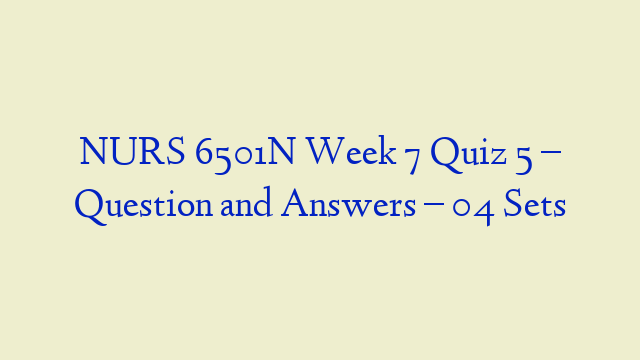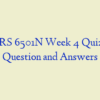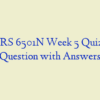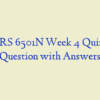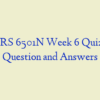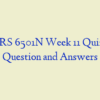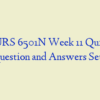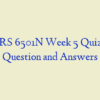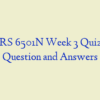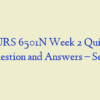Description
NURS 6501N Week 7 QUIZ Set 1 – Question and Answers
- When completing this quiz, did you comply with Walden University’s Code of Conduct including the expectations for academic integrity?
- How should the nurse prepare a patient who is to receive a Schilling test for pernicious anemia?
- A staff member wants to know where the greatest proportion of iron is located. How should the nurse respond? The greatest proportion of total body iron is located in the:
- A 21-year-old female was recently diagnosed with iron deficiency anemia. In addition to fatigue and weakness, which of the following clinical signs and symptoms would she most likely exhibit?
- The people from which country have the lowest risk for Hodgkin lymphoma?
- During an infection, the nurse assesses the lymph nodes. Lymph nodes enlarge and become tender because:
- A nurse monitors for the most common childhood cancer, which is:
- A 35-year-old female is diagnosed with vitamin B12 deficiency anemia (pernicious anemia). How should the nurse respond when the patient asks what causes pernicious anemia? A decrease in ______ is the most likely cause.
- The nurse will check which of the following tests to directly measure iron stores?
- When a nurse is reviewing lab results and notices that the erythrocytes contain an abnormally low concentration of hemoglobin, the nurse calls these erythrocytes:
- A 65-year-old male experienced loss of appetite, weight loss, lemon-yellow skin, liver enlargement, and a beefy red tongue shortly before his death. Autopsy suggested pernicious anemia, and the cause of death would most likely reveal:
- A 5-year-old male was diagnosed with normocytic-normochromic anemia. Which of the following anemias does the nurse suspect the patient has?
- A 10-year-old male presents with abdominal swelling, night sweats, fever, and weight loss. He is diagnosed with Burkitt lymphoma. Upon obtaining the history, which of the following is the most likely cause?
- A 62-year-old female tells her health care provider she has been experiencing regular night sweats that cause her to wake up drenched. She also remarks that she has been unintentionally losing weight. Physical exam reveals enlarged lymph nodes on her neck that do not appear to be painful. She should be screened for which of the following cancers?
- An adult patient’s blood sample is analyzed in a laboratory. Assuming a normal sample, which type of white blood cell accounts for the highest percentage?
- A 52-year-old male IV drug user was diagnosed with hepatitis C 5 years ago. He is now experiencing impaired blood clotting. The nurse suspects a decrease in which of the following vitamins?
- A newborn baby is diagnosed with a blood disorder in which her platelet count is low. Which of the following does the nurse suspect could be the reason?
- A 15-year-old male is diagnosed with infectious mononucleosis. When the patient asks how he got this disease, how should the nurse respond? The most likely cause is:
- A 45-year-old female undergoes a splenectomy to remove a tumor. Which of the following assessment finding is most likely to occur following surgery?
- After initial compensation, what hemodynamic change should the nurse monitor for in a patient who has a reduction in the number of circulating erythrocytes?
- A 50-year-old female is diagnosed with primary thrombocythemia. A nurse would expect the blood smear to reveal _____ platelets.
- A nurse is teaching the staff about platelets. Which information should the nurse include? In addition to playing a role in hemostasis, platelets have the ability to:
- A 60-year-old female emphysema patient experiences a rapid and pounding heart, dizziness, and fatigue with exertion. Which of the following respiratory assessment findings indicate the respiratory system is compensating for the increased oxygen demand? nurs 6501n week 7
- A 25-year-old female has a heavy menses during which she loses a profuse amount of blood. Which of the following adaptations should the nurse expect?
- A newborn is diagnosed with congenital intrinsic factor deficiency. Which of the following types of anemia will the nurse see documented on the chart?
- In disseminated intravascular coagulation (DIC), the nurse assesses for active bleeding after intravascular clotting because:
- Thrombocytopenia may be: nurs 6501n week 7
- A 35-year-old male with hyperthyroidism begins treatment to decrease thyroid activity. A nurse monitors for which of the following conditions that could result secondary to the treatment?
- A 20-year-old female undergoes lab testing for anemia. Results show high iron, bilirubin, and transferrin and low hemoglobin and hematocrit. Which of the following is the most likely diagnosis to be documented on the chart?
- While reviewing lab results, the nurse recalls the most abundant cells in the blood are:
- While checking lab results, the nurse remembers the normal leukocyte count is:
- A 45-year-old male is diagnosed with macrocytic, normochromic anemia. The nurse suspects the most likely cause of this condition is:
- A 5-year-old female is diagnosed with acute leukemia. The nurse will most likely treat this patient with:
- Which major symptom in a patient with sickle cell anemia indicates to the nurse, the patient is experiencing a vaso-occlusive crisis?
- A nurse is caring for a patient who cannot clot. Which end product of the clotting cascade is this patient unable to make?
- A 58-year-old female presents in the clinic presenting with fatigue, weight loss, and tingling in her fingers. Laboratory findings show low hemoglobin and hematocrit, a high mean corpuscular volume, and normal plasma iron. These assessment findings are consistent with which type of anemia?
NURS 6501N Week 7 Quiz Set 2
- After initial compensation, what hemodynamic change should the nurse monitor for in a patient who has a reduction in the number of circulating erythrocytes?
- While reviewing lab results, the nurse recalls the most abundant cells in the blood are:
- A 65-year-old male experienced loss of appetite, weight loss, lemon-yellow skin, liver enlargement, and a beefy red tongue shortly before his death. Autopsy suggested pernicious anemia, and the cause of death would most likely reveal:
- How should the nurse prepare a patient who is to receive a Schilling test for pernicious anemia?
- A nurse checks individuals with liver disease for clotting problems because:
- A 40-year-old male vegetarian is diagnosed with folate deficiency anemia. He reports that he is an alcoholic. Which of the following factors put him at greatest risk for developing his disease?
- A 58-year-old female presents in the clinic presenting with fatigue, weight loss, and tingling in her fingers. Laboratory findings show low hemoglobin and hematocrit, a high mean corpuscular volume, and normal plasma iron. These assessment findings are consistent with which type of anemia? nurs 6501n week 7
- A 45-year-old female undergoes a splenectomy to remove a tumor. Which of the following assessment finding is most likely to occur following surgery?
- The nurse will check which of the following tests to directly measure iron stores?
- When a nurse is reviewing lab results and notices that the erythrocytes contain an abnormally low concentration of hemoglobin, the nurse calls these erythrocytes:
- A nurse is caring for a patient who cannot clot. Which end product of the clotting cascade is this patient unable to make?
- A 15-year-old male with infectious mononucleosis is being given instructions on how to prevent the spread of this infection to others. Which statement represents a correct instruction?
- While checking lab results, the nurse remembers the normal leukocyte count is:
- A hematologist is discussing hematopoiesis. Which information should be included? ________ participate in hematopoiesis.
- A nurse is teaching the staff about platelets. Which information should the nurse include? In addition to playing a role in hemostasis, platelets have the ability to:
- Which major symptom in a patient with sickle cell anemia indicates to the nurse, the patient is experiencing a vaso-occlusive crisis?
- The people from which country have the lowest risk for Hodgkin lymphoma?
- For a patient experiencing hypersplenism, the nurse expects the erythrocytes to be:
- A staff member wants to know where the greatest proportion of iron is located. How should the nurse respond? The greatest proportion of total body iron is located in the:
- An adult patient’s blood sample is analyzed in a laboratory. Assuming a normal sample, which type of white blood cell accounts for the highest percentage?
- A 10-year-old male is diagnosed with sickle cell anemia. When the parents ask who is responsible for this disease, what is the nurse’s best response? He most likely inherited it from:
- A 10-year-old male is diagnosed with leukemia. The nurse assesses for which other condition that could be associated with his disease? nurs 6501n week 7
- A 60-year-old female emphysema patient experiences a rapid and pounding heart, dizziness, and fatigue with exertion. Which of the following respiratory assessment findings indicate the respiratory system is compensating for the increased oxygen demand?
- A 45-year-old male is diagnosed with macrocytic, normochromic anemia. The nurse suspects the most likely cause of this condition is:
- Which of the following individuals should the nurse assess first for a vitamin B12 deficiency anemia?
- A 10-year-old male presents with abdominal swelling, night sweats, fever, and weight loss. He is diagnosed with Burkitt lymphoma. Upon obtaining the history, which of the following is the most likely cause?
- A 20-year-old female undergoes lab testing for anemia. Results show high iron, bilirubin, and transferrin and low hemoglobin and hematocrit. Which of the following is the most likely diagnosis to be documented on the chart?
- In disseminated intravascular coagulation (DIC), the nurse assesses for active bleeding after intravascular clotting because:
- A 25-year-old female has a heavy menses during which she loses a profuse amount of blood. Which of the following adaptations should the nurse expect?
- A newborn is diagnosed with congenital intrinsic factor deficiency. Which of the following types of anemia will the nurse see documented on the chart?
- A 5-year-old female is diagnosed with acute leukemia. The nurse will most likely treat this patient with: nurs 6501n week 7
- A newborn baby is diagnosed with a blood disorder in which her platelet count is low. Which of the following does the nurse suspect could be the reason?
- A 21-year-old female was recently diagnosed with iron deficiency anemia. In addition to fatigue and weakness, which of the following clinical signs and symptoms would she most likely exhibit?
- A 34-year-old male presents in the emergency room with extreme fatigue and shortness of breath. His skin and sclera appear to have a yellowish discoloration. These assessment findings are consistent with which type of anemia?
- A nurse monitors for the most common childhood cancer, which is:
- When completing this quiz, did you comply with Walden University’s Code of Conduct including the expectations for academic integrity?
NURS 6501N Week 7 Quiz Set 3
- A 10-year-old male is diagnosed with sickle cell anemia. When the parents ask who is responsible for this disease, what is the nurse’s best response? He most likely inherited it from:
- The nurse will check which of the following tests to directly measure iron stores? nurs 6501n week 7
- A nurse is caring for a patient who cannot clot. Which end product of the clotting cascade is this patient unable to make?
- A 40-year-old male vegetarian is diagnosed with folate deficiency anemia. He reports that he is an alcoholic. Which of the following factors put him at greatest risk for developing his disease?
- A newborn is diagnosed with congenital intrinsic factor deficiency. Which of the following types of anemia will the nurse see documented on the chart?
- A 15-year-old male is diagnosed with infectious mononucleosis. When the patient asks how he got this disease, how should the nurse respond? The most likely cause is:
- A 52-year-old male IV drug user was diagnosed with hepatitis C 5 years ago. He is now experiencing impaired blood clotting. The nurse suspects a decrease in which of the following vitamins?
- For a patient experiencing hypersplenism, the nurse expects the erythrocytes to be:
- A 5-year-old female is diagnosed with acute leukemia. The nurse will most likely treat this patient with:
- Thrombocytopenia may be:
- A 60-year-old female emphysema patient experiences a rapid and pounding heart, dizziness, and fatigue with exertion. Which of the following respiratory assessment findings indicate the respiratory system is compensating for the increased oxygen demand?
- A 35-year-old female is diagnosed with vitamin B12 deficiency anemia (pernicious anemia). How should the nurse respond when the patient asks what causes pernicious anemia? A decrease in ______ is the most likely cause.
- While checking lab results, the nurse remembers the normal leukocyte count is:
- A 62-year-old female tells her health care provider she has been experiencing regular night sweats that cause her to wake up drenched. She also remarks that she has been unintentionally losing weight. Physical exam reveals enlarged lymph nodes on her neck that do not appear to be painful. She should be screened for which of the following cancers?
- A 45-year-old female undergoes a splenectomy to remove a tumor. Which of the following assessment finding is most likely to occur following surgery?
- During an infection, the nurse assesses the lymph nodes. Lymph nodes enlarge and become tender because:
- Which major symptom in a patient with sickle cell anemia indicates to the nurse, the patient is experiencing a vaso-occlusive crisis?
- How should the nurse prepare a patient who is to receive a Schilling test for pernicious anemia?
- A newborn baby is diagnosed with a blood disorder in which her platelet count is low. Which of the following does the nurse suspect could be the reason?
- After initial compensation, what hemodynamic change should the nurse monitor for in a patient who has a reduction in the number of circulating erythrocytes?
- A 5-year-old male was diagnosed with normocytic-normochromic anemia. Which of the following anemias does the nurse suspect the patient has?
- A 10-year-old male presents with abdominal swelling, night sweats, fever, and weight loss. He is diagnosed with Burkitt lymphoma. Upon obtaining the history, which of the following is the most likely cause?
- When a nurse is reviewing lab results and notices that the erythrocytes contain an abnormally low concentration of hemoglobin, the nurse calls these erythrocytes:
- A 65-year-old male experienced loss of appetite, weight loss, lemon-yellow skin, liver enlargement, and a beefy red tongue shortly before his death. Autopsy suggested pernicious anemia, and the cause of death would most likely reveal:
- A 25-year-old female has a heavy menses during which she loses a profuse amount of blood. Which of the following adaptations should the nurse expect?
- The people from which country have the lowest risk for Hodgkin lymphoma?
- A 58-year-old female presents in the clinic presenting with fatigue, weight loss, and tingling in her fingers. Laboratory findings show low hemoglobin and hematocrit, a high mean corpuscular volume, and normal plasma iron. These assessment findings are consistent with which type of anemia?
- A 67-year-old female has chronic gastrointestinal bleeding. A nurse recalls the primary cause of her anemia is:
- A staff member wants to know where the greatest proportion of iron is located. How should the nurse respond? The greatest proportion of total body iron is located in the:
- A 20-year-old female undergoes lab testing for anemia. Results show high iron, bilirubin, and transferrin and low hemoglobin and hematocrit. Which of the following is the most likely diagnosis to be documented on the chart?
- While reviewing lab results, the nurse recalls the most abundant cells in the blood are:
- A 50-year-old female is diagnosed with primary thrombocythemia. A nurse would expect the blood smear to reveal _____ platelets.
- A nurse is teaching the staff about platelets. Which information should the nurse include? In addition to playing a role in hemostasis, platelets have the ability to:
- A 34-year-old male presents in the emergency room with extreme fatigue and shortness of breath. His skin and sclera appear to have a yellowish discoloration. These assessment findings are consistent with which type of anemia?
- Which of the following individuals should the nurse assess first for a vitamin B12 deficiency anemia?
NURS 6501N Week 7 Quiz Set 4
- A 58-year-old female presents in the clinic presenting with fatigue, weight loss, and tingling in her fingers. Laboratory findings show low hemoglobin and hematocrit, a high mean corpuscular volume, and normal plasma iron. These assessment findings are consistent with which type of anemia?
- A 40-year-old male vegetarian is diagnosed with folate deficiency anemia. He reports that he is an alcoholic. Which of the following factors put him at greatest risk for developing his disease?
- A 5-year-old male was diagnosed with normocytic-normochromic anemia. Which of the following anemias does the nurse suspect the patient has?
- A 65-year-old male experienced loss of appetite, weight loss, lemon-yellow skin, liver enlargement, and a beefy red tongue shortly before his death. Autopsy suggested pernicious anemia, and the cause of death would most likely reveal:
- Thrombocytopenia may be:
- A 20-year-old female undergoes lab testing for anemia. Results show high iron, bilirubin, and transferrin and low hemoglobin and hematocrit. Which of the following is the most likely diagnosis to be documented on the chart?
- A 52-year-old male IV drug user was diagnosed with hepatitis C 5 years ago. He is now experiencing impaired blood clotting. The nurse suspects a decrease in which of the following vitamins?
- A nurse is teaching the staff about platelets. Which information should the nurse include? In addition to playing a role in hemostasis, platelets have the ability to:
- In disseminated intravascular coagulation (DIC), the nurse assesses for active bleeding after intravascular clotting because:
- A 10-year-old male is diagnosed with leukemia. The nurse assesses for which other condition that could be associated with his disease?
- For a patient experiencing hypersplenism, the nurse expects the erythrocytes to be:
- An adult patient’s blood sample is analyzed in a laboratory. Assuming a normal sample, which type of white blood cell accounts for the highest percentage?
- The nurse will check which of the following tests to directly measure iron stores?
- A 45-year-old female undergoes a splenectomy to remove a tumor. Which of the following assessment finding is most likely to occur following surgery?
- A 10-year-old male is diagnosed with sickle cell anemia. When the parents ask who is responsible for this disease, what is the nurse’s best response? He most likely inherited it from:
- While checking lab results, the nurse remembers the normal leukocyte count is: nurs 6501n week 7
- A newborn is diagnosed with congenital intrinsic factor deficiency. Which of the following types of anemia will the nurse see documented on the chart?
- A hematologist is discussing hematopoiesis. Which information should be included? ________ participate in hematopoiesis.
- While reviewing lab results, the nurse recalls the most abundant cells in the blood are:
- After initial compensation, what hemodynamic change should the nurse monitor for in a patient who has a reduction in the number of circulating erythrocytes?
- A 5-year-old female is diagnosed with acute leukemia. The nurse will most likely treat this patient with:
- How should the nurse prepare a patient who is to receive a Schilling test for pernicious anemia?
- A 15-year-old male with infectious mononucleosis is being given instructions on how to prevent the spread of this infection to others. Which statement represents a correct instruction?
- A 35-year-old male with hyperthyroidism begins treatment to decrease thyroid activity. A nurse monitors for which of the following conditions that could result secondary to the treatment?
- A staff member wants to know where the greatest proportion of iron is located. How should the nurse respond? The greatest proportion of total body iron is located in the:
- A 10-year-old male presents with abdominal swelling, night sweats, fever, and weight loss. He is diagnosed with Burkitt lymphoma. Upon obtaining the history, which of the following is the most likely cause?
- A 62-year-old female tells her health care provider she has been experiencing regular night sweats that cause her to wake up drenched. She also remarks that she has been unintentionally losing weight. Physical exam reveals enlarged lymph nodes on her neck that do not appear to be painful. She should be screened for which of the following cancers? nurs 6501n week 7
- A group of cells isolated in the laboratory have membrane-bound granules in their cytoplasm and they show phagocytic activity. Which of the following cells is most similar?
- A 25-year-old female has a heavy menses during which she loses a profuse amount of blood. Which of the following adaptations should the nurse expect?
- A 67-year-old female has chronic gastrointestinal bleeding. A nurse recalls the primary cause of her anemia is:
- A nurse is caring for a patient who cannot clot. Which end product of the clotting cascade is this patient unable to make?
- When a nurse is reviewing lab results and notices that the erythrocytes contain an abnormally low concentration of hemoglobin, the nurse calls these erythrocytes:
- A nurse checks individuals with liver disease for clotting problems because:
- Which of the following individuals should the nurse assess first for a vitamin B12 deficiency anemia?
- A 21-year-old female was recently diagnosed with iron deficiency anemia. In addition to fatigue and weakness, which of the following clinical signs and symptoms would she most likely exhibit?
NURS 6501N Week 7 Quiz Set 5
- An 8-week-old male was recently diagnosed with cystic fibrosis. Which of the following digestive alterations would be expected?
- In alcoholic cirrhosis, hepatocellular damage is caused by: nurs 6501n week 7
- A 3-month-old female develops colicky pain, abdominal distention, and diarrhea after drinking cow’s milk. The best explanation for her symptoms is:
- The nurse assessing the patient with biliary atresia would expect to find which primary clinical manifestation?
- The primary complication of enterocolitis associated with Hirschsprung disease is related to which finding?
- A 45-year-old male complains of heartburn after eating and difficulty swallowing. He probably has:
- The cardinal sign of pyloric stenosis caused by ulceration or tumors is:
- The most common cause of chronic vascular insufficiency among the elderly is:
- For the patient experiencing esophageal reflux, the nurse would expect which sphincter to be malfunctioning?
- An 8-week-old female is diagnosed with a congenital heart disease and Down syndrome. Her parents report that she has difficulty defecating. X-ray reveals anorectal malformation that causes complete obstruction often referred to as:
- A 27-year-old male presents with fever, GI bleeding, hepatomegaly, and transient joint pain. He reports that as a child he received blood transfusions following a motor vehicle accident. He also indicates he was vaccinated against hepatitis B. Which of the following types of hepatitis does the clinician think he most likely has?
- Cholecystitis is inflammation of the gallbladder wall usually caused by:
- A 55-year-old female has general symptoms of gallstones but is also jaundiced. IV cholangiography would most likely reveal that the gallstones are obstructing the:
- A 55-year-old male died in a motor vehicle accident. Autopsy revealed an enlarged liver caused by fatty infiltration, testicular atrophy, and mild jaundice secondary to cirrhosis. The most likely cause of his condition is:
- A 24-year-old male who sustained a head injury and fractured femur develops a stress ulcer. A common clinical manifestation of this ulcer is:
- A 40-year-old male develops an intestinal obstruction related to protrusion of the intestine through the inguinal ring. This condition is referred to as:
- A 60-year-old male presents with GI bleeding and abdominal pain. He reports that he takes NSAIDs daily to prevent heart attack. Tests reveal that he has a peptic ulcer. The most likely cause of this disease is:
- Acute pancreatitis often manifests with pain to which of the following regions? nurs 6501n week 7
- A 50-year-old male is experiencing reflux of chyme from the stomach. He is diagnosed with gastroesophageal reflux. This condition is caused by:
- The most common clinical manifestation of portal hypertension is _____ bleeding.
- Outbreaks of hepatitis _____ often occur in young children attending day care centers and can be attributed to poor hand washing.
- A 40-year-old female presents complaining of pain near the midline in the epigastrium. Assuming the pain is caused by a stimulus acting on an abdominal organ, the pain felt is classified as:
- Which of the following characteristics is associated with an acute occlusion of mesenteric blood flow to the small intestine?
- Kwashiorkor is a severe dietary deficiency of:
- Which of the following symptoms would help a health care provider distinguish between ulcerative colitis and Crohn disease?
- A 54-year-old male is diagnosed with peptic ulcer disease. This condition is most likely caused by:
- A 6-month-old male infant is brought to the ER after the sudden development of abdominal pain, irritability, and vomiting followed by passing of “currant jelly” stool. Ultrasound reveals intestinal obstruction in which the ileum collapsed through the ileocecal valve and invaginated into the large intestine. This type of obstruction is referred to as: nurs 6501n week 7
- A 16-year-old female presents with abdominal pain in the right lower quadrant. Physical examination reveals rebound tenderness and a low-grade fever. A possible diagnosis would be:
- Prolonged diarrhea is more serious in children than adults because:
- Marasmus is most common in children of which age group?
- The cardinal signs of small bowel obstruction are:
- The exocrine portion of the pancreas contains:
- A 22-year-old male underwent brain surgery to remove a tumor. Following surgery, he experienced a peptic ulcer. His ulcer is referred to as a(n) _____ ulcer.
- A 2-month-old female with Down syndrome is diagnosed with Hirschsprung disease following family complaints of chronic constipation. The most likely cause of these symptoms is:
- A 60-year-old male is diagnosed with cancer of the esophagus. Which of the following factors most likely contributed to his disease?
